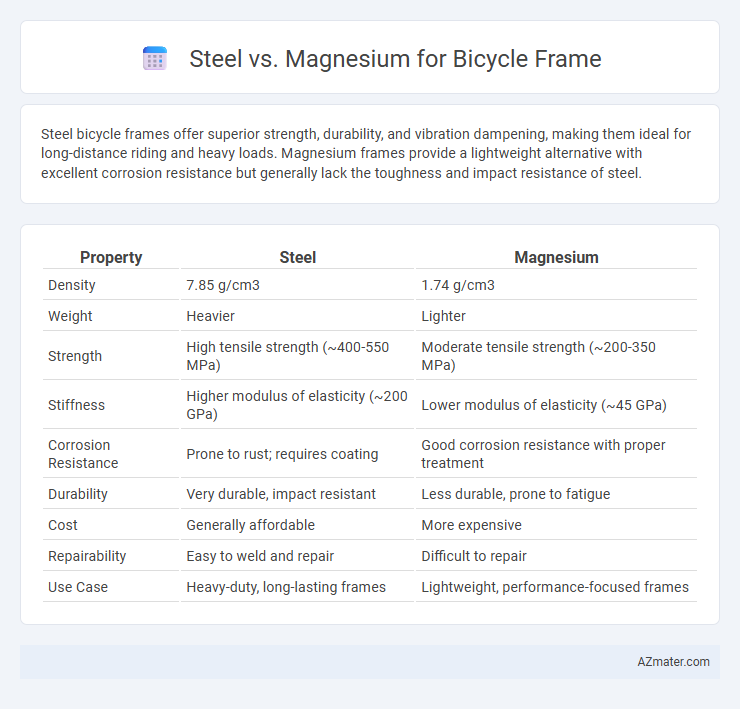Steel bicycle frames offer superior strength, durability, and vibration dampening, making them ideal for long-distance riding and heavy loads. Magnesium frames provide a lightweight alternative with excellent corrosion resistance but generally lack the toughness and impact resistance of steel.
Table of Comparison
| Property | Steel | Magnesium |
|---|---|---|
| Density | 7.85 g/cm3 | 1.74 g/cm3 |
| Weight | Heavier | Lighter |
| Strength | High tensile strength (~400-550 MPa) | Moderate tensile strength (~200-350 MPa) |
| Stiffness | Higher modulus of elasticity (~200 GPa) | Lower modulus of elasticity (~45 GPa) |
| Corrosion Resistance | Prone to rust; requires coating | Good corrosion resistance with proper treatment |
| Durability | Very durable, impact resistant | Less durable, prone to fatigue |
| Cost | Generally affordable | More expensive |
| Repairability | Easy to weld and repair | Difficult to repair |
| Use Case | Heavy-duty, long-lasting frames | Lightweight, performance-focused frames |
Introduction: Steel vs Magnesium Bicycle Frames
Steel bicycle frames offer exceptional strength, durability, and a smooth ride due to their inherent flexibility and vibration absorption properties. Magnesium frames are valued for their lightweight characteristics and corrosion resistance, making them ideal for performance-oriented cycling. Comparing tensile strength, weight, and fatigue resistance highlights steel's robust longevity against magnesium's advantage in reducing overall bike mass.
Material Properties: Steel and Magnesium Compared
Steel offers superior strength and durability with high tensile strength typically around 400-550 MPa, making it ideal for heavy-duty bicycle frames that require toughness and impact resistance. Magnesium boasts a significantly lower density (about 1.74 g/cm3) compared to steel (around 7.85 g/cm3), resulting in lighter frames while maintaining reasonable strength, although its tensile strength ranges from 160-280 MPa, which is lower than steel. Corrosion resistance is another factor where magnesium requires protective coatings due to its susceptibility to oxidation, whereas steel, especially stainless variants, provides better inherent resistance to rust and wear.
Frame Weight and Ride Feel
Steel bicycle frames typically weigh more than magnesium frames, with steel averaging around 2.5 to 3.5 kilograms compared to magnesium's lighter range of 1.5 to 2.5 kilograms. Ride feel on steel frames is often described as smooth and compliant due to steel's natural vibration-damping properties, providing a comfortable ride on rough surfaces. Magnesium frames offer a stiffer and more responsive ride, enhancing acceleration and handling but may transmit more road vibrations to the rider.
Durability and Longevity
Steel bicycle frames offer exceptional durability and resistance to fatigue, maintaining structural integrity over decades even under heavy use. Magnesium frames provide a lightweight alternative but generally have lower corrosion resistance and a shorter lifespan due to susceptibility to environmental factors and metal fatigue. Riders prioritizing long-term frame durability often prefer steel for its proven longevity and repairability in various riding conditions.
Stiffness and Vibration Damping
Steel bicycle frames offer superior vibration damping due to their high density and inherent material elasticity, providing a smoother ride on rough surfaces. Magnesium frames excel in stiffness-to-weight ratio, delivering a lightweight structure with enhanced rigidity, which improves power transfer during pedaling. However, magnesium's lower damping capacity can result in a harsher ride feel compared to steel, impacting rider comfort over long distances.
Corrosion Resistance and Maintenance
Steel bicycle frames offer excellent corrosion resistance when treated with rust-proof coatings such as powder coating or paint, but they require regular maintenance like cleaning and reapplication of protective layers to prevent rust, especially in humid or wet conditions. Magnesium frames naturally resist corrosion better due to their oxide layer, but they are prone to galvanic corrosion if exposed to certain metals or environments, necessitating specific protective treatments and careful maintenance. Both materials demand ongoing care to maintain durability, with steel needing more frequent inspections for rust and magnesium requiring specialized corrosion inhibitors to enhance longevity.
Cost and Availability
Steel bicycle frames generally offer a more affordable option due to the widespread availability and lower cost of raw materials and manufacturing processes compared to magnesium. Magnesium frames tend to be pricier because of the metal's higher material cost and more specialized production techniques, which are less common in the bicycle industry. Steel's extensive global supply chain ensures easier sourcing and replacement, making it a cost-effective choice for budget-conscious cyclists and manufacturers.
Customization Options
Steel offers superior customization options for bicycle frames due to its ease of welding, brazing, and shaping, allowing frame builders to tailor geometry and tubing thickness to rider specifications. Magnesium frames, while lightweight and corrosion-resistant, present challenges in customization because of limited fabrication techniques and less experience among frame manufacturers. Enthusiasts seeking personalized geometry, tube selection, and intricate detailing typically prefer steel for its versatility and repairability.
Environmental Impact
Steel bicycle frames have a higher carbon footprint due to energy-intensive production processes and mining for iron ore, but their durability and recyclability contribute to long-term environmental benefits. Magnesium frames, while lighter and offering improved fuel efficiency during transportation, involve environmentally challenging extraction of magnesium from seawater or magnesium-rich minerals, leading to significant energy consumption and emissions. The choice between steel and magnesium affects the overall environmental impact based on lifecycle analysis, recyclability rates, and manufacturing energy sources.
Which Material is Best for You?
Steel offers exceptional durability and shock absorption, making it ideal for riders seeking comfort and long-lasting frames, especially for touring or commuting. Magnesium, being significantly lighter, appeals to cyclists prioritizing speed and agility, but it may compromise on strength and corrosion resistance compared to steel. Choosing the best material depends on your riding style, weight preferences, and maintenance willingness, with steel favored for robustness and magnesium for lightweight performance.

Infographic: Steel vs Magnesium for Bicycle Frame
 azmater.com
azmater.com